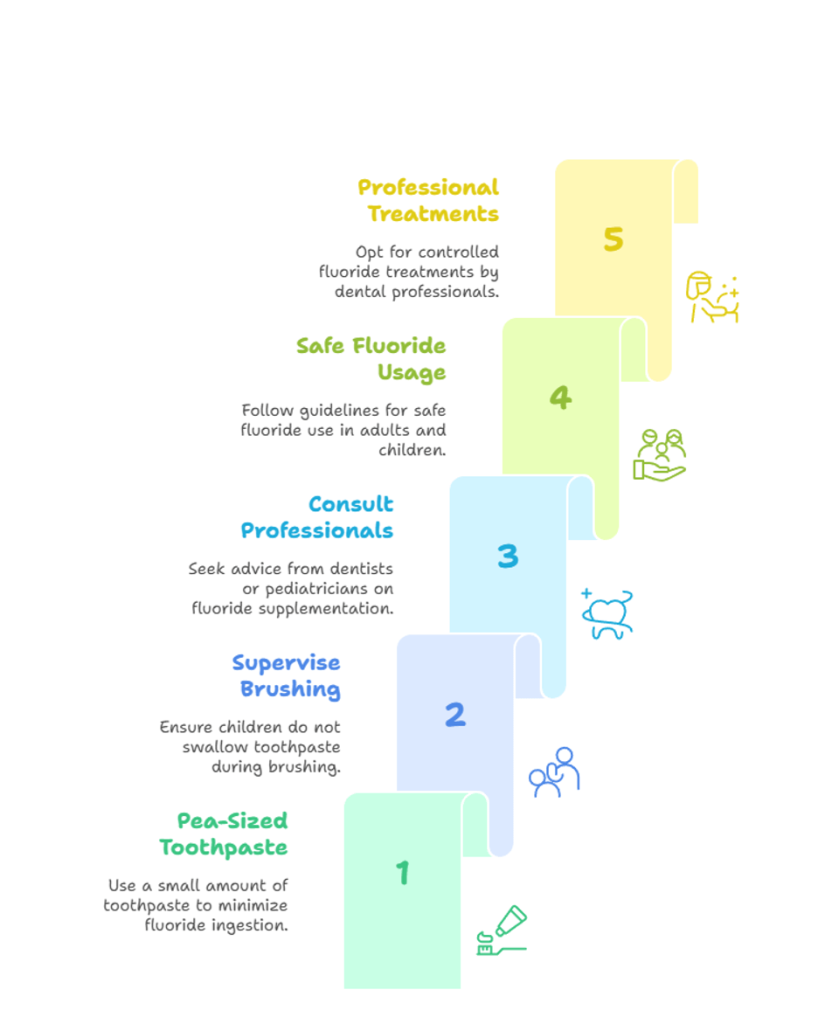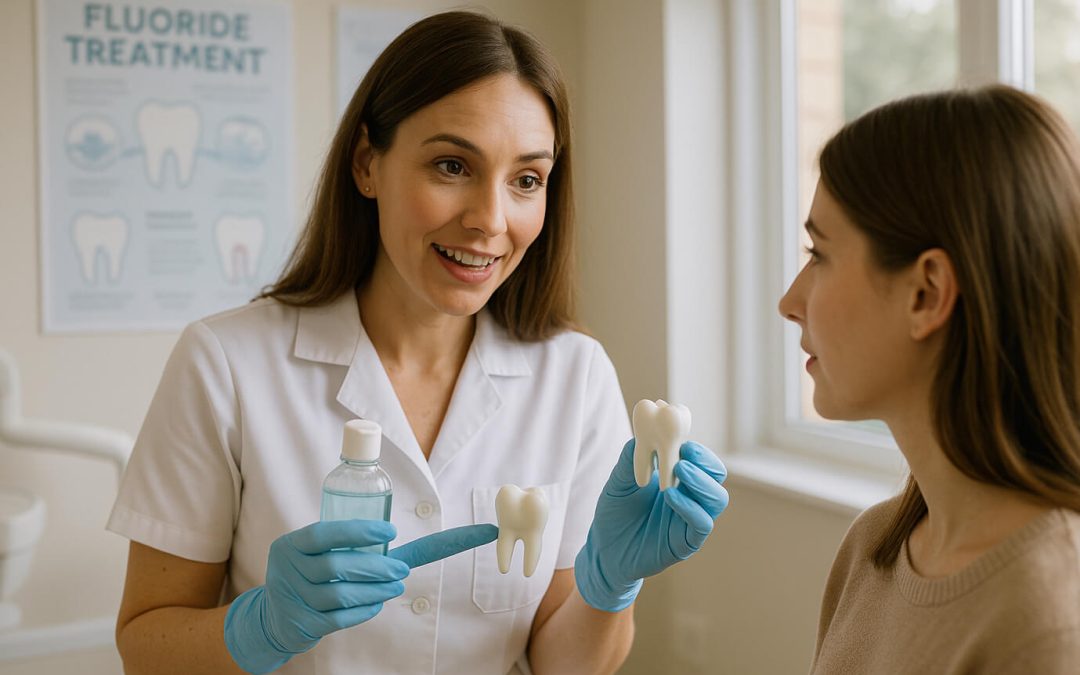Fluoride treatments are a common and effective way to protect your teeth from decay, but it’s natural to have questions and concerns about any potential risks. At Bur Oak Dental, we understand these concerns and are committed to providing safe and informative care.
This article aims to address common misconceptions and provide accurate information about fluoride treatments, ensuring you feel confident and informed about your oral health choices.
What is Fluoride and How Does It Work?
Fluoride is a naturally occurring mineral that strengthens tooth enamel, making it more resistant to acid attacks from bacteria and sugars in the mouth. It works by:
- Remineralization: Fluoride helps to rebuild and strengthen weakened enamel.
- Inhibiting Bacteria: It reduces the ability of bacteria to produce acid.
Common Concerns and Misconceptions About Fluoride
Despite its proven benefits, fluoride has been the subject of some controversy. Let’s address some of the most common concerns:
- Fluorosis: One of the most frequent concerns is fluorosis, a cosmetic condition that can occur when children consume excessive fluoride during tooth development.
- Neurological Effects: Some people worry about potential neurological effects of fluoride.
- Overall Safety: A general concern about the safety of fluoride and its potential long-term effects.
Rest assured, reputable organizations like the American Dental Association (ADA) and the Centers for Disease Control and Prevention (CDC) support the use of fluoride due to its effectiveness in preventing tooth decay.
Understanding Fluorosis
Fluorosis is a cosmetic condition that can cause white spots or streaks on the teeth. It occurs when children are exposed to excessive fluoride during the years when their permanent teeth are forming (typically before age 8).
- Mild Fluorosis: In most cases, fluorosis is mild and barely noticeable. It appears as small, white spots on the teeth and does not affect their health or function.
- Severe Fluorosis: Severe fluorosis is rare and can cause more pronounced discoloration and pitting of the enamel.
Preventing Fluorosis:
Parents can minimize the risk of fluorosis by –
- Using only a pea-sized amount of fluoride toothpaste for children.
- Supervising children while brushing to ensure they don’t swallow toothpaste.
- Consulting with a dentist or pediatrician about appropriate fluoride supplementation.
Safe Fluoride Usage and Dosage

The key to safe fluoride use is moderation. Here are some guidelines to keep in mind:
- Adults: Adults can safely use fluoride toothpaste and mouthwash as directed.
- Children: Children should use fluoride products under parental supervision, using only a pea-sized amount of toothpaste.
- Professional Treatments: Fluoride treatments administered by a dental professional are carefully controlled to ensure safety and effectiveness.
At Bur Oak Dental, we follow strict protocols to ensure that fluoride treatments are safe for all our patients.
Fluoride Treatments at Bur Oak Dental
We offer several types of fluoride treatments at our Markham locations to help protect your teeth:
- Fluoride Varnish: A thin coating painted onto the teeth.
- Fluoride Gel: Applied using a tray that fits over the teeth.
- Fluoride Foam: Similar to gel, but in foam form for easy application.
Our dental professionals will assess your individual needs and recommend the most appropriate treatment for you.
Can I drink water after a fluoride treatment?
After a fluoride treatment at Bur Oak Dental, we generally advise patients to wait at least 30 minutes before eating or drinking.
This allows the fluoride to be fully absorbed by the tooth enamel, maximizing its protective effects.
Following this simple guideline helps ensure the treatment is as effective as possible in strengthening your teeth against decay.
Benefits of Fluoride Treatments
Fluoride treatments offer numerous benefits, including:
- Preventing Tooth Decay: Fluoride strengthens tooth enamel, making it more resistant to acid attacks.
- Reversing Early Decay: It can help to reverse early signs of tooth decay.
- Protecting Teeth from Acid: Fluoride provides a protective barrier against acids produced by bacteria in the mouth.
By incorporating fluoride treatments into your dental care routine, you can enjoy a healthier, brighter smile for years to come.
Conclusion
While it’s understandable to have concerns about the risks associated with fluoride treatments, it’s important to remember that when administered by qualified professionals, they are safe and effective. At Bur Oak Dental, we prioritize your safety and well-being, and we are committed to providing you with the highest quality of care.
If you have any questions or concerns about fluoride treatments, please don’t hesitate to contact us. We’re here to help you make informed decisions about your oral health.
Book your fluoride treatment today!
FAQs:
- Is fluoride treatment safe for children and adults?
Yes, when used appropriately, fluoride treatments are safe for both children and adults. Dental professionals apply fluoride in controlled amounts to strengthen enamel and prevent tooth decay. The dosage is well within safe limits recommended by dental and public health authorities.
- Can fluoride cause any side effects or health issues?
In very high doses over long periods, fluoride can lead to dental fluorosis (white spots on teeth) or, in extreme cases, skeletal fluorosis. However, these risks are extremely rare in clinical settings. Professional treatments are carefully administered to avoid overexposure.
- What’s the difference between naturally occurring fluoride and the fluoride used in dental treatments?
Both types of fluoride are chemically similar. Fluoride used in dental care is purified and formulated for maximum benefit and safety. It mimics the effects of naturally occurring fluoride found in water and foods but is applied more precisely to prevent cavities.
- Are there common myths about fluoride that I should be aware of?
Yes. Some myths claim fluoride is toxic or linked to serious illnesses, but these claims are not supported by scientific evidence. When used as directed, fluoride is a safe, effective tool in preventing tooth decay and is endorsed by major dental and health organizations worldwide.
- How can I prevent fluorosis in children while still protecting their teeth?
The key is moderation. Use a pea-sized amount of fluoride toothpaste for kids under 6 and supervise brushing to ensure they don’t swallow toothpaste. Professional fluoride applications at the dentist are dosed carefully and pose no risk of fluorosis when guidelines are followed.


